-
I'm having a luthier build me a nice archtop...kind of a hybrid between a box and a thinline semi hollow. I got a little tripped up when it came time to decide on what kind of wood to use on the neck. I chose to have a laminated neck because I like the look and it has structural advantages. But the debate came about when I asked about using flamed maple.
My luthier's opinion is that he only uses flamed maple for a neck because of its aesthetic...it looks damn nice, but it is a heavier wood. He concluded that when going purely for tone, he suggested a lighter wood...so we ended up going with Honduras mahogany.
Anybody have any thoughts or experience with this?
-
06-08-2014 07:03 AM
-
FWIW mahogany is the wood of choice for classical guitar necks, where acoustic tone means everything. It may be tradition, but there is probably a couple of hundred years of experimentation which means it is the standard. But if cosmetics are important, you could always go for a mixture - Ibanez favours maple-mahogany laminates.
-
Really interesting topic.
I for one, wouldn't use mahogany because I think, adding anything to an archtop that makes it darker and slower (if those two terms make sense) is not the way I like to go. For me, everything on an archtop, should be firm and responsive, because the sound box itself tends to go in the other direction.
I don't think the classical guitar comparison is a good one. They're so much smaller and therefore need the warmth of Cedar and mahogany/rosewood to make it pleasing to the ear. Archtops are at the other end of the spectrum.
I guess kinda why people like maple on Les Pauls and Aldrer on Strats. People like dark, but not too dark, so the Mahogany strat or Les Paul is jot so popular.
Then again, I'm thinking of my archtop tone as being amplified as well as acoustic. If you where going all acoustic then maybe mahogany is a better choice?
-
We're in for a lively debate here, or a good discussion. It's a personal thing. It depends a lot on how well you know yourself, how well you know what you want, how important traditions are and understanding where those traditions come from.
So here're just my ideas based on three decades of playing, building, feeling and listening. My humble opinion.
There IS a difference. No debate here. The tradition in archtops has always been maple. It imparts a round immediacy to the attack, colours the decay with what I think of as a clarity and focus. Please keep in mind that fingerboard material is very important too. It's often coupled with ebony in high end instruments.
Mahogany can be lighter, though I've worked with some really dense and heavy mahogany. It's a variable wood and there are different kinds. Honduras is sought after, Philippino is to be avoided. I feel I get a warmer sound from mahogany. It's got a character that colours that attack in, to my ear, is a very musical way. It's the key to what many hear/feel is the characteristic humble sound of the ES-175. (there are maple neck and maho neck 175s out there. You can get some idea from comparing.) Mahogany is also more prevalent in lower priced instruments because often mahogany was easier and cheaper to get in large quantities and so it went on lower priced instruments. That's a tradition born of economics and not necessarily musicality or personal taste.
So the top end instruments wound up being made with maple and ebony fingerboards, rarer, and denser, and the low end instruments wound up being made of mahogany and rosewood.
As a player and having built with many materials, I've come to favour a mahogany multi piece neck with a maple centre strip and now I'm beginning to use synthetic or alternative wood fingerboards. The amount of good ebony is past peak and the market drives the use of bad wood; in ebony and in Braz rosewood. Personally, I like what I feel is a voice like warmth from mahogany, the density of a touch of maple and the freedom of choosing the high quality of a fingerboard wood that has NOT been depleted by an inflexible tradition driven market. I've also had very good luck with walnut necks, which I feel are similar to maple with a bit more warmth in the stock I've used and played. Not enough out there to make any kind of absolute statement though.
In the end, one of the advantages of having a custom instrument IS having the luxury of flying in the face of tradition. Know your options. Try them out. Turn out the voice of "It's always been this way because it must be better" and know your choices, and keep your knowledge of alternatives in mind too. ' had a customer order an instrument. He didn't know his own playing well enough to make an informed choice so he went with traditional maple. Looks terrific. Plays really nicely, but after living with it, he didn't find the voice inspiring. It was then that he tried a softer neck wood on someone else's instrument and it fit his personality. He ordered a second. He liked it more. He still doesn't play either enough to justify the effort of building them ha ha. You get the idea.
Have a great partnership with your lovely instrument and I hope your fantasies and ideals are realized.
DavidLast edited by TH; 06-08-2014 at 08:33 AM.
-
Great post TruthHertz. The only thing I would have added to your spot on commentary is how the rest of the wood and construction of the guitar might add to, or detract from the desired tone . . and alter the resulting tone. It is possible to make choices that would work in contrast to, rather than in harmony of the choice to with go with a hog neck for tonal character.
Maple neck, ebony finger board 2-3/4" depth, laminate top & back with top being parallel braced.
hog neck, rosewood FB 3-1/4" depth X braced thin carved and tap tuned solid top and back?
Thickness of ebony or rosewood FB?
profile of neck . . . width of neck . . . size/mass of head stock?
floating FB?
tongue and mortise or dove tail neck joint?
Everything's gotta work in harmony and each choice in each catagory needs to be made in consideration of how the choices will interact with each other.Last edited by Patrick2; 06-08-2014 at 02:48 PM.
-
I think most LP necks ARE mahogany.
 Originally Posted by GoergeBenson
Originally Posted by GoergeBenson
-
Who is the luthier? What are the other specs of the guitar?
Even though it is a joy to specify a custom guitar down to the last detail, there is a risk that you (or me, or a bunch of guys on the Internet) know less than your luthier. Perhaps you can play some music and talk with him, so he can help and advise you...
On guitars that I have had built, I take charge of the aesthetics, describe carefully or as best I can the kind of playing I do and the response I want, and leave most wood choices to the builder.
-
In simple terms harder denser woods are brighter and can add to sustain of the note. Less dense woods can be more resonate. Now the key is the combination of woods between neck, fretboard, and body woods. Fender Custom Shop used to have a series of video on tone of different woods and how they advise customers on selecting woods. Yes, Fender is mainly solid bodies but the comments about the woods can apply. Also I've seen some videos on YouTube on luthiers tapping wood blanks to determine tone of the woods.
Bottom line the guitar is a result of the combination of woods selected.
-
There is an overlap in both aesthetics and tonal response. If you are mandating your aesthetics . . then you are probably contributing to the end resulting tone of the instrument.
 Originally Posted by kamlapati
Originally Posted by kamlapati
-
Agreed. And then there's the internal resonance of the individual neck, mass of machines, and a huge chapter of variables. We once built a neck, mahogany, and it just didn't have a solidity to the instrument. It was a light mahogany. We took a frequency resonance off the neck mode and it was out of phase with the body, totally off by just a tiny amount. 'drilled a hole in the headstock and filled with with lead ballast. The instrument came to life like magic. Another time a classical guitar had a chunky sound, big voice. Player wanted the profile shaved down. The stiffness must have been right on the edge of the optimum range because after that the guitar was not the same. There have been times when the placement of a graphite rod parallel with the truss rod has changed the output noticibly, both in maple and mahogany. But that's another art entirely.
 Originally Posted by Patrick2
Originally Posted by Patrick2
Just to say there's a lot to it beyond a simple answer, and a whole lot more than an opinion formed without a lot of experience. The advice to trust the luthier, GOOD advice. Want a better custom guitar, get a better luthier.
The fellow I worked with was so good at making good guitars, people began bringing him their other custom guitars to be optimized by him. Not good for his business. Not fair to the original luthier. But the guitars did sound great after he tuned the plates and brought necks into phase. There's another forum entirely.
David
-
As suggested by earlier posts, I share the opinion that neck wood species can matter, but the variables within a given species, and overlaps from maple to mahog', make blanket statements about as useful as usual.
And 100% agree as David mentions, that tuner mass can be a huge variable - and of course one that in many cases can be easily varied 'ex post build-o'.
Love the idea of a specialist in optimizing a guitar. Not so crazy at all considering how often a fresh view can be so much help.
Chris
-
I prefer the sound of mahogany necks, although ironically enough only my flattop acoustic and my Rick Turner RN-6 have mahogany necks- my archtops both have maple necks. IMHO the mahogany neck makes for a warmer and more resonant instrument with a slightly softer attack; a maple neck makes for a brighter tone. Depends on what you want.
Benedetto mentions something along these lines in his book and Parker said something along the lines of thinking that a mahogany neck is also more stable than a maple neck over time in an interview out on the webs somewhere.
That said, there are a a lot of classic archtop tones with maple necks. D'Angelico and D'Aquisto favored them, just to mention two...
-
Great info on this thread so far. I wanted to get some unbiased opinions without divulging any info at all...let's see if anything changes after hearing the guitar info.
I'm having this guitar built by Victor Baker. After an extensive search, I found Victor's work to just call to me in a way nothing else did. His guitars are so truly unique and absolutely incredible.
The model we came up with is very similar to the GHex signature model, but my model is called the p28. Sitka spruce top, flamed maple b/s, ebony fingerboard, dual pickups, 12" radius, 25" scale length, 14" bout. I was ready to change it to a 15" body but Victor convinced me to keep 14" as he said he thinks is nice and punchy. The body depth was a huge part of designing this instrument. The 2 3/8" depth is really unique...right in between a jazz box and a thinline. Everything is fully bound aside from the F holes.
The neck is another unique part of my model. We modeled it after a neck from my collection that I really love...a thick 7/8" large C shape. We measured specs from a signature Strat. It's a laminated neck as well.
I'm happy with my choice of Honduras mahogany for the neck after reading all these posts. I also think because the neck is gonna be pretty beefy and thick, the lighter mahogany will yield better results. The combination of mahogany with a flamed maple center strip has me intrigued...
-
If I had a choice, mahogany neck with an ebony centre strip.
-
Interesting, I've never heard of that. Know of any picture examples?
 Originally Posted by Jabberwocky
Originally Posted by Jabberwocky
-
Not uncommon in classical circles. It gives it a lot of stability and when I've seen them, it's been a relatively narrow "racing stripe" type combination. Nice look. Understated. I've seen narrow ebony 3 and I've seen a tendency towards wider maple, and I've seen 5 piece with maple bookmatched wings, a different material centre and a contrasting band of a darker colour in between. It's sound, aesthetic appeal, craziness and the staying hand of your luthier in the end.
 Originally Posted by Jabberwocky
Originally Posted by Jabberwocky
To throw another thought into the churning cauldron, I've been excited about synthetic fingerboards and persimmon fingerboards. Still giving them the beta test trials but so far results are very favourable and I do expect we'll see it becoming more common with the preponderance of bad ebony and Lacey act concerns.
Sounds like a nice guitar you're having built, bluewaterpig. Share the results and the ongoing story with us.
David
-
Victor knows how his guitars sound, so I'd trust his opinion. Period.
-
http://www.kohno-guitar.org/products...image/back.jpg
 Originally Posted by bluewaterpig
Originally Posted by bluewaterpig
-
Lol was talking about the body :-)
 Originally Posted by Woody Sound
Originally Posted by Woody Sound
-
As we speak about how all things might affect tonal response from a stringed instrument, please take a look at the photos below. This is the neck of an 18" arch top with spec's identical to a Super 400, with the exception of a 3-1/4" body depth as opposed to a 3-1/2" on the Super 4. That makes it a slightly larger box than the Heritage Super Eagle.
A couple things to note here; the significant mass at the head stock by nature of its size, volute and also its thickness at 5/8". The tuners are the larger and heavier Imperials. 3 piece neck . . maple/ebony/maple. 2 graphite rods inserted on both sides of the truss rod. Full neck profile with moderately full shoulders. The finger board is West African Gabon ebony, un-dyed jet black in color. The scalloped neck heel for better upper fret access was also unique to this luthier's arch tops.
The top and the back plates are graduated a bit more than the Super 4 and the Super Eagle. The top plate and back plates, while not tap tuned to pitch . . are voiced . . . as in tap *refined* (tuning to pitch vs voicing) with the X bracing also being shaved and voice refined as well. The top plate is sitka with a fairly consistent 26-ish grain lines per inch.
The tail piece is bell brass. The size, type and placement of the KA pup was also a spec taken into consideration, as was the significant mass of the bridge base.
The tone . . . it rings out like a grand piano!
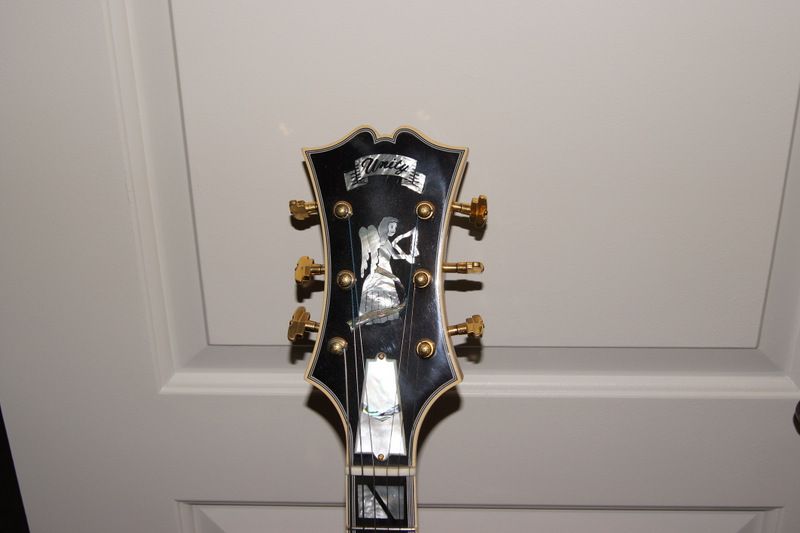
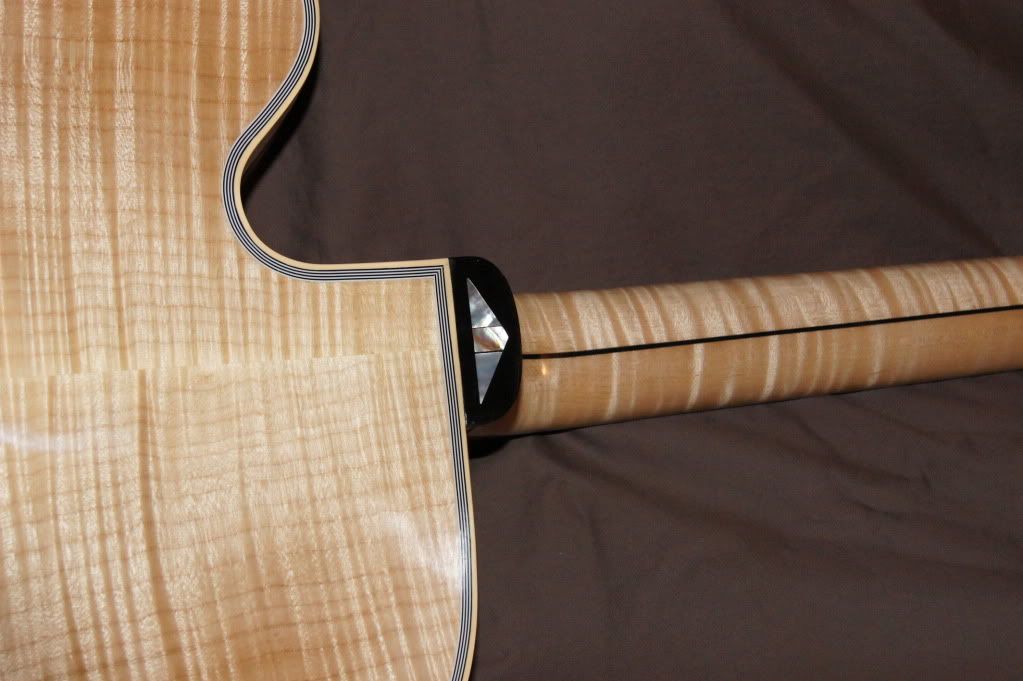
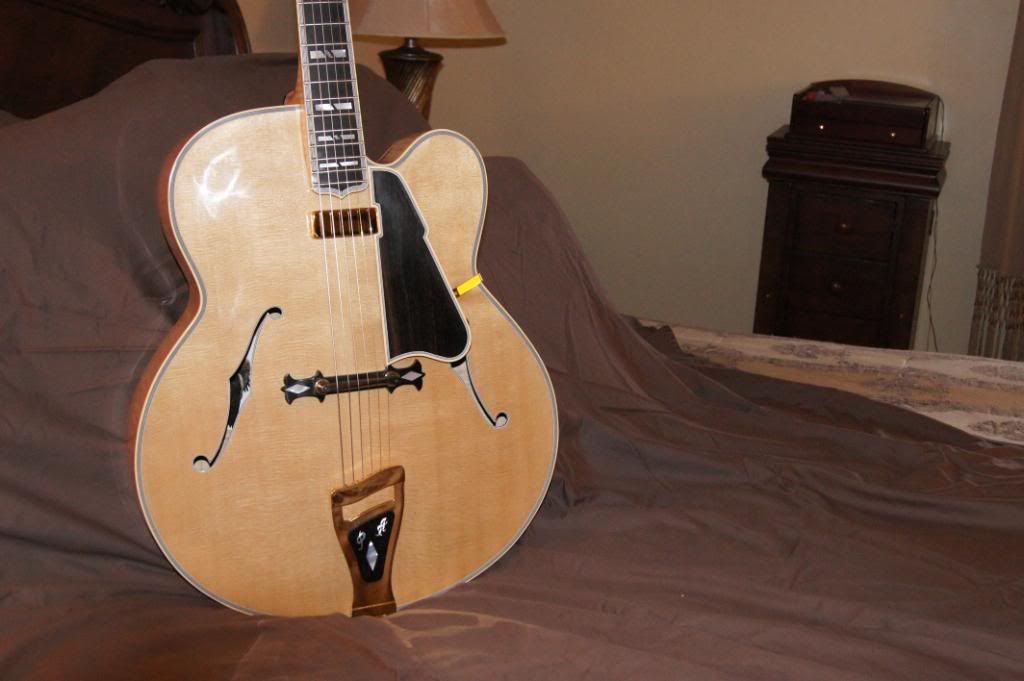
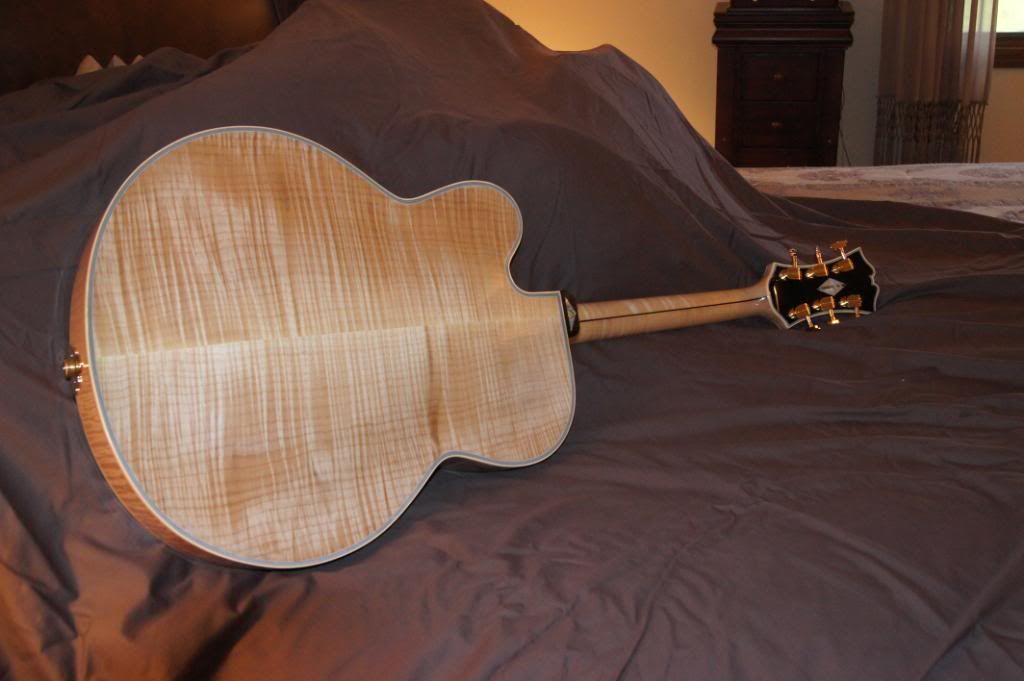
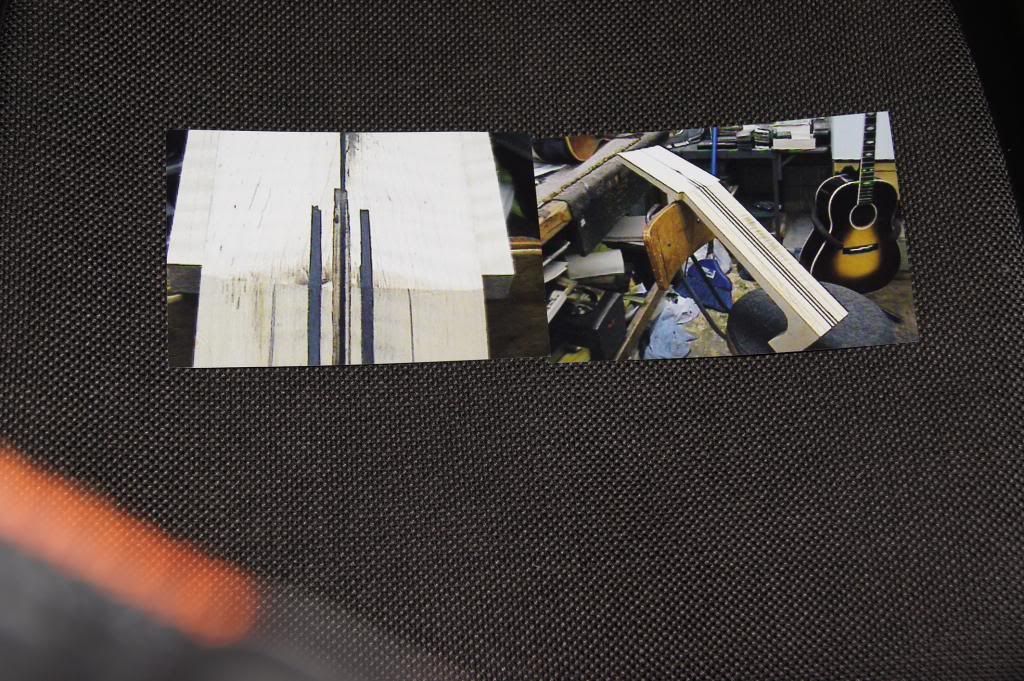
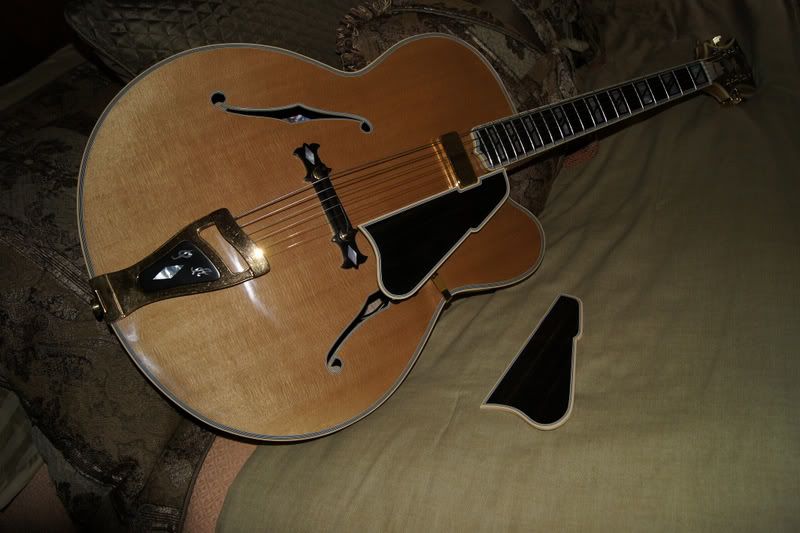

Last edited by Patrick2; 06-09-2014 at 12:23 PM.
-
Ok SO.......
Victor just emailed me and said he doesn't think he can get the stripe effect I asked for by using mahogany (I asked for two stripes running down the neck).
He did say he has a lighter weight flamed maple neck block that he could do it with though.
Im really torn...do I go with flamed maple to get the stripe look and everything or just say use mahogany?? Does the difference in wood REALLLLLY make that much of a difference in tone??
What would you guys do??
Update: VB also gave me a third choice since I said one lamination stripe would be ok...Spanish Cedar, which he said is the "ultimate" choice for tone.Last edited by bluewaterpig; 06-09-2014 at 01:58 PM.
-
Well, at the risk of being so presumptous as to question a great luthier like Victor Baker, the first thing I would do would be to ask Victor . . . "Why the hell can't you?" There are very light colored and weighted species of hog . . and the contrast between that and any darker colored wood striping would be significant . . especially with two stripes. There are also composit materials of a very dark color, which could be used for the center striping.
 Originally Posted by bluewaterpig
Originally Posted by bluewaterpig
As to your question about . . . "REALLLLLY" . . . the short answer is, YES.
If you're going with a maple neck, IMO rock maple would be the better choice for stability. Rock maple is not light weighted. I wouldn't sacrifice stability for aesthetics if I was making the decision.
Listen, man . . you're the customer .. . Victor's the builder. If you want a 5 piece neck with visible contrast . . then that's what you should receive. It's your nickel.
-
Maple, will help with the resale. If this isn't going to be your last guitar, then don't back yourself into corners.
Plus if we all had our perfect guitars, we would be bored in a second. Its the character that we bond with and sometimes the more dysfunctional, the more we like them. You can't sell that, nor 100% quantify/control it.
You might think mahogany sounds better but prefer the feel and weight of maple. Whats the trade off?
And if you go with mahogany and you don't like the way the guitar sounds, thats definitely put you up the creek.
But as my fellow english would say
"He who dares Rodders, He who Dares"! (That is to say, if you go for it, you might get your perfect/dream guitar. And Since it seems to be what your trying to do, might as well take the risk).
Of course easy to say without putting my money down :-)
-
For what you're going for with this build especially (i.e. somewhere between a box and a thinline), I can't imagine it will make a difference that is noticeable through the amp, or even acoustically for that matter...but really not through the amp. Each guitar is different so even if you could A/B two seemingly identical instruments with maple vs. mahagony necks, unless you have the exact same type and age of strings as well as identical pickup and string adjustments, you can't really know whether that's the neck talking.
-
This is sorta tangential, but I recently bought a 2nd PRS that has a solid rosewood neck. That neck resonates more than the other PRS with mahogany. But, the rosewood has some sort of dull satin oil(?) finish (instead of hard gloss), and that might have something to do with it. Idk.




 Reply With Quote
Reply With Quote







Pickup Suggestions For Blonde 89 Emperor
Yesterday, 07:27 PM in Guitar, Amps & Gizmos